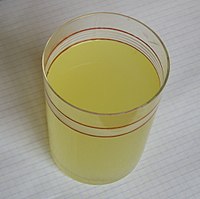
Photo from wikipedia
With the increased use of information and communication technology-based tools and devices across traditional desktop computers and smartphones, models and decision-support systems are becoming more accessible for farmers to improve… Click to show full abstract
With the increased use of information and communication technology-based tools and devices across traditional desktop computers and smartphones, models and decision-support systems are becoming more accessible for farmers to improve the decision-making process at the farm level. However, despite the focus of research and industry providers to develop tools that are easy to adopt by the end user, milk-production prediction models require substantial parameterization information for accurate milk production simulations. For these models to be useful at an individual animal level, they require the potential milk yield of the individual animals (and possibly potential fat and protein yields) to be captured and parameterized within the model to allow accurate simulations of the interaction of the animal with the system. The focus of this study was to link 3 predicted transmitting ability (PTA) traits from the Economic Breeding Index (PTA for milk yield, fat, and protein) with potential index parameters for milk, fat, and protein required as inputs to a herd-based dynamic milk model. We compiled a data set of 1,904 lactations that included different experiments conducted at 2 closed sites during a 14-yr period (2003-2016). The treatments implied different stocking rates, concentrate supplementation levels, calving dates, and genetic potential. The first step, using 75% of the data randomly selected, was to link the milk, fat, and protein yields achieved within each lactation to their respective PTA value, stocking rate, parity, and concentrate supplementation level. The equations generated were transformed to correspond to inputs to the pasture-based herd dynamic milk model. The equations created were used in conjunction with the model to predict milk, fat, and protein production. Then, using the remaining 25% data of the data set, the simulations were compared against the actual milk produced during the experiments. When the model was tested, it was capable of predicting the lactation milk, fat, and protein yield with a relative prediction error of <10% at the herd level and <13% at the individual animal level.
Journal Title: Journal of dairy science
Year Published: 2019
Link to full text (if available)
Share on Social Media: Sign Up to like & get
recommendations!